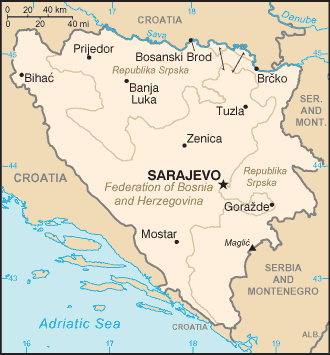Bosnia and Herzegovina
The territories of today's Bosnia and Herzegovina were part of Illyria and later part of the Roman Empire (provinces Dalmatia and Pannonia). After the fall of Rome, the area was contested by the Byzantine Empire and Rome's successors in the West. Slavs settled the region in the 7th century. The first mention of the term Bosnia is in De Administrando Imperio, a book by Constantine Porphyrogenitus, Byzantine emperor and historian. The kingdoms of Serbia and Croatia split control of Bosnia and Herzegovina in the 9th century. The 11th and 12th centuries saw the rule of the region by the kingdom of Hungary. The medieval banate of Bosnia gained autonomy by the end of the 12th century, and grew into an independent kingdom in 1377 under king Tvrtko Kotromanić. Bosnia remained independent up until 1463, when Ottoman Turks conquered the region and established the Ottoman province of Bosnia. In these times there also lived a certain amount of adherents to the so-called Bosnian Church (variously referred to as krstjani, bogumili, etc) which belonged neither to the Western nor to the Eastern Christian churches. During the four centuries of Ottoman rule, many Bosnians dropped their ties to Christianity in favor of Islam, including most of the faithful of the Bosnian Church. Bosnia was under Ottoman rule until 1878, when it became a colony under Austria-Hungary. While those living in Bosnia were from 1908 officially in the Austro-Hungarian Empire, South Slavs in Serbia and elsewhere were calling for a South Slav state; World War I began with the assassination in Sarajevo of Archduke Ferdinand, heir to the Austro-Hungarian throne, which was organized by Serb nationalists. Following the war, Bosnia became part of the South Slav kingdom of Serbs, Croats and Slovenes (later renamed to kingdom of Yugoslavia). When Yugoslavia was invaded in World War II, all of Bosnia and Herzegovina was ceded to Nazi-puppet Croatia. The Cold War saw the establishment of the Communist Yugoslavia under Tito, and the reestablishment of Bosnia and Herzegovina as a republic within its Ottoman borders. The Bosnian-Herzegovinian declaration of sovereignty in October of 1991, was followed by a referendum for independence from Yugoslavia in February 1992 boycotted by the Bosnian-Herzegovinian Serbs. Serbia and Bosnian Serbs responded shortly thereafter with armed attacks on Bosnian-Herzegovinian Croats and Bosniaks aimed at partitioning the republic along ethnic lines and joining Serb-held areas. The UNPROFOR (UN Protection Force) was deployed in Bosnia and Herzegovina in mid-1992. 1992 and 1993 saw the greatest bloodshed in Europe after 1945. In March 1994, Bosniaks and Croats reduced the number of warring factions from three to two by signing an agreement creating a joint Bosniak-Croat Federation of Bosnia and Herzegovina. Each nation reported many casualties in the three sided conflict, in which the Bosniaks reported the highest number of deaths and casualties. However, the only case officially ruled by the U.N. Hague tribunal as genocide was the Srebrenica massacre of 1995. At the end of the war more than 200,000 had been killed and more than 2 million people fled their homes (including over 1 million to neighboring nations and the west). On November 21, 1995, in Dayton, Ohio, presidents of Bosnia and Herzegovina (Alija Izetbegović), Croatia (Franjo Tuđman), and Serbia (Slobodan Milošević) signed a peace agreement that brought a halt to the three years of war in the Republic of Bosnia and Herzegovina (the final agreement was signed in Paris on 14 December 1995). The Dayton Agreement succeeded in ending the bloodshed in Bosnia and Herzegovina, and it institutionalized the division between the Bosnian-Herzegovinian Muslim and Croat entity - Federation of Bosnia and Herzegovina (51% of the territory), and the Bosnian-Herzegovinian Serb entity - Republika Srpska (49%). The enforcement of the implementation of the Dayton Agreement was through a UN mandate using various multinational forces: NATO-led IFOR (Implementation Force), which transitioned to the SFOR (Stabilisation Force) the next year, which in turn transitioned to the EU-led EUFOR at end of 2004. The civil administration of Bosnia and Herzegovina is headed by the High Representative of the international community.
This article is licensed under the GNU Free Documentation License. It uses material from the Wikipedia article "Bosnia". |
||||||||||

